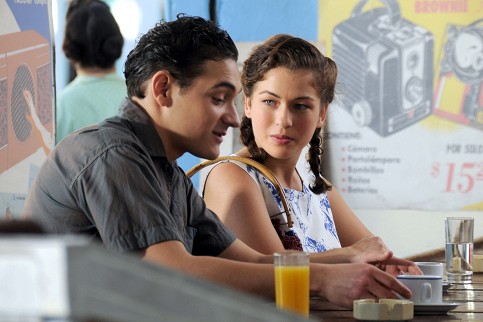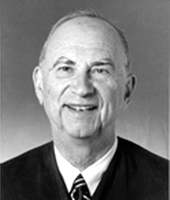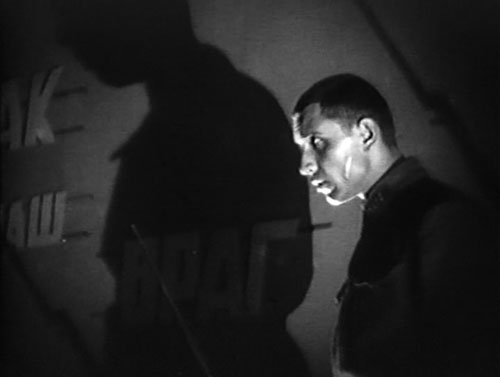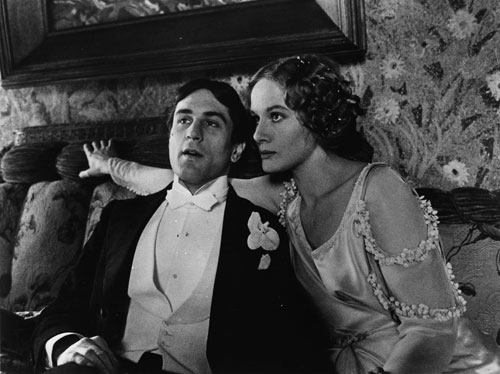Best of the Bay 2011 Editors Picks
Food and Drink

A beignet craze has swept the Bay, and really, who could withstand the fiendish temptation of these deep-fried, sugar-sprinkled, French-by-way-of-New-Orleans brunch delights? Our current favorites come courtesy of the new Devil’s Teeth Baking Company in the Sunset which, despite its intimidating name, traffics in heavenly pastries. (The bakery’s name is actually a tribute to a sobriquet for the Farallone Islands.) The diabolically good bakers here have even set aside a day for beignet worship: zip down to beignet Sundays and fill those idle hands with made-to-order clouds of perfection — and cups of Blue Bottle coffee to boot. While you’re there, score a batch of spice-chunked ginger cookies or a gooey-sweet pie. Followed by a stroll down Ocean Beach? Yes please, Mr. Mephistopheles.
3876 Noriega, SF. (415) 683-5533. www.devilsteethbakingcompany.com
A one-room schoolhouse feel, minus the ‘marm but plus the mac? That seems right for a light-hearted, full-flavored spot that zaps you back — maybe not to Little House on the Prairie days (although the ingredients are Ingalls-fresh), but at least to second grade, when a grilled cheese and tomato soup were all the haute cuisine one needed. Oakland’s cute Homeroom makes us want to check that we have both of our mittens clipped to our sleeves as we dive into updated youth classics: grilled cheese with Inna jalapeño jam, Blue Lake string beans, and Three Twins root beer floats. Best of all, oodles of mac ‘n’ cheese, made with everything from tangy chevre to hot chorizo, Gilroy garlic to vegan-version walnut. School’s in for summer!
400 40th, Oakl. (510) 597-0400, www.homeroom510.com
If they shoot horses (don’t they?) and make garlic ice cream, they might as well whip up a dessert with pork in it. And they do: the peanut butter pie at Straw, a nifty little carnival-themed restaurant that opened recently on Octavia Boulevard in Hayes Valley. The pie filling is a luxurious mousse and the crust is chocolate, so you could make a good case that such a confection wouldn’t need pork — or anything else. But in the spirit of fun, the kitchen does lay some bits of candied bacon atop each slice. Candied bacon! When Homer Simpson finally dies and goes to heaven, this is what he will feast on. Until then, you can treat yourself to a little taste.
203 Octavia, SF. (415) 431-3663, www.strawsf.com
Aficionados of Southern cooking will agree that a slice of pecan pie is a nice way to end a meal. But even if you don’t like pecan pie — or you’re forswearing all desserts for some reason — you can still help yourself to a big slice of the glass pie at Criolla Kitchen, because the New Orleans-influenced restaurant is itself a big slice of glass pie. The wedge-shaped space is window-intensive, looks westward, and is splashed with sunlight in its many shades and tempers. It’s like the second coming of Zuni Cafe. In such an enchanted setting, it could be easy for the food to slip, but not here; from the hushpuppies to the po’boys to (yes!) the pecan pie, the kitchen consistently delivers.
2295 Market, SF. (415) 552-5811, www.criollakitchen.com
Meet Salvatore Cimino: barber by day, 1512 Spirits whiskey distiller by night. His unaged but surprisingly balanced Barbershop Rye — of which he makes only 350 bottles per month — makes it clear that this man knows spirits as well as he does scissors. As plainly evidenced from the bottle, which displays a 1923 photo of Cimino’s grandfather in Prohibition-era Potrero Hill, he hails from a long line of distillers. But his eyes are on the future: Cimino hopes to release a classic bourbon and cherry-smoked bourbon to expand 1512’s lineup. Sip these locally-made spirits at bars across the city, or get a pour with a shave at Cimino’s 1512 Barbershop in Nob Hill.
www.1512spirits.com
You are to be pardoned if you approach the nondescript brick SoMa building that houses Una Pizza Napoletana, walk through the door (plate glass, like the rest of the façade), and have the brief sensation of arriving at an art gallery between installations. Or perhaps the high-ceilinged, white-walled cube — with a turquoise-tiled conical shape rising from the center — seems more like a museum? No. It’s a pizzeria, home to tattooed chef and former New Yorker Anthony Mangieri, and the tiled shrine is the pizza oven. Pizza is the sole objet d’art: that’s it, nothing more, no sides, substitutions, condiments, nada. The drill isn’t quite as severe as on Seinfeld’s “Soup Nazi” episode, but it’s still a singular — and tasty — experience.
210 11th St., SF. (415) 861-3444, www.unapizza.com/sf

When the Bourbon and Branch crew took over the former Tenderloin bar Club 441, it dubbed the bar Mr. Lew’s Win Win Bar & Grand Sazerac Emporium for a birthday party for B and B creative director. The renaming was meant as a one-night joke, but the name stuck (regulars shorten it to “441”. Whatever you call it, the dive — naturally — serves quality Sazeracs and other classic cocktails. Everyone gets into cheesy movie Wednesdays: Top Gun led to a group rendition of “You’ve Lost That Lovin’ Feeling,” complete with a craft-cocktailed gentleman belting atop the bar. Though there’s talk of remodeling, we hope 441 stays as is: a dingy, sticky place where industry insiders can grab a well-made post-shift drink.
441 Jones, SF. (415) 474-2284, www.mrlews.com
Sure, there are plenty of places in the Mission to park it and plug in, but the Summit Café provides the chance to nosh on cocoa nib nougatine and buttermilk bubbles (no stale croissants here) while the ol’ MacBook boots up. The Summit my seem steep — a tiny mocha is $5 and most desserts are $9 or $10 — but the payoff is oh-so-sweet. The concept behind Summit is innovative in a techie way: it hopes to combine work and home into a “third space” to foster broader interaction and creativity. So while basically working forever, we’ll happily gorge on a rotating dessert menu full of high quality ingredients and imaginative concoctions (think beet fluid gel and Summit-exclusive Humphry Slocombe espresso balsamic ice cream) as we whip up that superhuman invisibility app.
780 Valencia, SF. (415) 861-5330, www.thesummit-sf.com
Waits are long at dingy, bustling Hong Kong Lounge, but on weekends you’ll be kept company by multigenerational Chinese families — kids and grandparents bonding over mountainous cheap meals. Like all superlative dim sum spots, not only is a meal here blessedly affordable (generally $2-$6 for dim sum plates), there are unusual items — like deep-fried coffee pork ribs that taste robustly of a cup of joe — to keep things interesting. We’re in love with the Lounge’s egg yolk almond balls: they’re doughy and filled with yellow sweet cream that looks like yolk. The balls taste similar to Chinese egg custards and are coated in almond shavings for a satisfying crunch.
5322 Geary, SF. (415) 668-8836
Waits can be epic at Plow, which has become Potrero’s brunch destination in the year since it opened. But there’s no reason to spin your wheels — try the breakfast and lunch menus Tuesday through Friday for quicker comestibles. For a midday meal, you could hardly do better than Plow’s grilled cheese sandwich. It’s always bracketed by thick slabs of Acme bread, but its filler rotates: one day you might be noshing on Vermont cheddar accompanying a Point Reyes Toma, on another you’ll sink into Gruyere and creamy fromage blanc with sweet oven-roasted tomatoes. Collect them all! It’s certainly a possibility — sandos this good have us craving another by the last bite.
1299 18th St., SF. (415) 821-7569, www.eatatplow.com

We’ve been raving about good cheer and good food at Leopold’s since it opened in January. The masses quickly followed suit and the Austrian hofbrau has been packed ever since. Tip back German, American, and Belgian draft beers at hearty pinewood tables under animal heads and Austrian art — a warm, welcoming space created by Sazlberg natives and brothers Albert and Klaus Rainer. With comforting Hungarian goulash (the border between Hungary and Austria is a shifty thing) and traditional wiener schnitzel, you’ll never make it out of here hungry — just make sure you save room for the apfelstrudel.
2400 Polk, SF. (415) 474-2000, www.leopoldssf.com
The gracious husband and wife team behind the beans at Brown Owl Coffee have been roasting together as Hearth Coffee Roasters for a few years now. Their passion shows — the two serve lush coffees at their tiny, cozy cafe. Impeccable cappuccinos and a mean cup of drip pair well with breads and pastries from local producers like Mi2Sweets; Oakland’s Pepples Donuts; and baklava from Richmond Egyptian restaurant Al Masri. Affogato lovers, take note — theirs is a beaut, made with Straus vanilla ice cream. Tucked out in the avenues, Brown Owl’s a big “how now?” to those who locate SF’s superior beans solely Mission and SoMa-side.
1131 Taraval, SF. (415) 242-1426, www.brownowlcoffee.com
San Franciscans are lucky to have educational opportunities like the Boothby Center for the Beverage Arts. Over the last year — since it debuted during SF Cocktail Week — it has played host to a slew of classes, tastings, and events regarding all things drink. Of course, cocktails and spirits are heavily represented, but founder H. Joseph Ehrmann also envisions coffee classes, tea and wine seminars — and more — for the future of his Mixology 101 series. With classes like “One Bourbon, One Scotch, One Beer” and “When It’s Cocktail Time in Cuba” (a journey through Cuba’s cocktail and rum heyday), learning was never so much — hic! — fun.
1161 Mission, Suite 120, SF. Facebook: Boothby Center for the Beverage Arts
You’ll know it by the smell of slow-roasting ribs and pulled pork: on weekdays Smoke BBQ generally parks its truck on a semi-desolate warehouse stretch of Bayview-Hunters Point. The pulled pork has a satisfying juiciness, reflecting its Midwest roots. The brisket and ribs are well loved by local worker bees. But what gives the meats a run for their money is the Smoke BBQ’s BBQ beans. Rich broth, smoky beans, and fatty chunks of pork — so good you just might forget your carnivorous entree.
1438 Davidson, SF. (415) 312-1637 www.smokebbqsf.com

The year was 2010, a flim-flam was erupting over the high alcohol content of kombucha sold long after its bottling date — and large companies with their complicated supply lines were compelled to pull their brews from grocery store shelves. Not so House Kombucha, SF’s little ‘bucha bottler that could. The Sixth Street factory was able to gain a sturdy market share due to its local distribution and small company profile — not to mention its sustainable practices (the company recently announced a 42 percent bottle return rate — that 50-cent deposit really works!). Best of all: we got to continue drinking its delicate vanilla orchid root and rose black tea flavors uninterrupted.
Available at various Bay Area grocery stores. housekombucha.food.officelive.com
If we could even fake the exuberance that Vegansaurus editor-founder Laura Beck trips out willy-nilly in her sparklingly sassy blog posts sans animal products … we’d be running to the store a lot more for economy-sized boxes of capital letters and exclamation points. But the site’s zazz is by no means irritating — indeed, we consider its daily updates on the hottest new vegan grub dens, footwear, and activist news required reading for leading a sexy, cutting-edge vegan lifestyle in the Bay (and with the addition of new writers, the country). Plus, the site dares to say everything non-meaties tend to suppress for politeness’ sake. Sample quote on animal-abusive lab workers: “I hope they get totally fucked by justice!”
www.vegansaurus.com
There’s a saying that goes “the French make cognac, but they drink Armagnac.” Add an “as do San Franciscans” parenthetical to the truism, because one 76-year-old Fillmore Street liquor store stocks a collection of the superior Gallic brandy fit to spawn a connoisseur. We refer to D&M Liquors’ Armagnac selection, which includes $50 bottles of Tariquet for everyday sips as well as Veuve J. Goudoulin Vieux Bas vintages dating back to 1929 and bottled especially for the store. Ex-D&M employee Charles Neal set up this transatlantic partnership and proceeded to (literally) write the book on the subject — Armagnac: The Definitive Guide to France’s Premier Brandy. Unfamiliar with Armagnac? The friendly staff are happy to give you the 411.
2200 Fillmore, SF. (415) 346-1325, www.dandm.com
We like our sandwiches the way Comcast and peep shows like their customers: pay-per-view. We don’t want no pre-made, plastic-wrapped, sittin’ around sandwiches. We want to watch. And we especially want to watch if hunky Italian uomini are making the sandwiches, and hunky construction worker uomini are waiting for them, and hunky delivery uomini are picking them up. Which brings us to Calabria Bros. in Potrero Hill, where what appear to be three generations of Vinnies manhandle (in a good way) the various cheeses, peppers, and salted pig parts to meet your specifications. The bros also put out a drool-worthy daily special (meat balls on Thursdays, chicken parm Fridays). Whatever sandwich you choose, the brothers will ask if you want it with their homemade garlic spread. Say yes.
2249 17th St., SF. (415) 863-1213, www.calabriabrosdeli.com
We love smoked salmon. Cold-smoked, hot-smoked, maple-smoked, pepper-smoked — especially wild and locally caught salmon purchased from a seasoned Half Moon Bay fisherman named Pietro Pavarrano. But we also recognize that there are other fish in the sea, especially the Caspian Sea. And when we’re in that transoceanic frame of mind, we head to New World Market in the Richmond, where the no-nonsense Russians who run the place offer dozens of species of smoked fish, ranging from sturgeon to sea bass to fish you’ve never heard of. While we’re there, we also like to pick up the housemade borscht, kefir, and — to undo all the good effects of the beets in the borscht and the priobiotics in the kefir — some chocolate babka and an Obolon beer from the Ukraine.
5641 Geary, SF. (415) 751-8810
Ah, the French. They may be derided as pretentious and spoofed for pomposity, but really, is there anything more irresistibly charmant than a mâitre d’ with a French accent who runs to greet, addresses you as “monsieur” or “madame,” kisses your hand, and almost renders you dizzy with the inebriating bonhomie wafting from his person? We don’t think so. And when we want this kind of treatment — and some superlative food and wine — we head to Bistro Central Parc. A Panhandle institution long before NoPa was NoPa (the neighborhood) and NoPa had Nopa (the restaurant), this friendly Francais fixture excels at staples like beef bourguignon and duck confit. Can’t find it? Follow the neighbors, and the mingled smells of bouillabaisse and frites.
560 Central, SF. (415) 750-1111. www.bistrocentralparc.com

Yuca — sounds like yucky, often looks and tastes like same. Turquoise-splashed Puerto Rican restaurant Parada 22 in the Upper Haight turns that yuca to yum. Rarely eaten here, yuca is the deliciously inescapable side dish for the bulk of the entrees, the centerpiece of the vegetarian platter, and the base of the yucca, avocado and garlic soup. Even as a standalone side, mashed and marinated in onion, olive oil, garlic, and spices, it shines. Parada 22’s savory way with the cassava root (as it’s known in much of the USA) complements home-style island favorites like tender, oregano-suffused pernil asado pork and a piquant pollo encebollado (chicken smothered in onions). For real starch maniacs, order a side with the truly scrumptious mofongo, mashed plantains with shrimp criolla.
1805 Haight, SF. (415) 750-1111. www.parada22.com
Revisit the era of California’s four robber barons — those capitalist tycoons who plundered their way to railroad riches in gold-rushing 19th-century California — at the Huntington Hotel’s Big Four Restaurant. Kitty-corner from the austere spires of Grace Cathedral (built on the earthquake-ravaged land of the Big Four’s Charles Crocker himself), the Bay’s premier lounge pianist Michael Parsons tinkles the joint’s keys while congenial barkeeps Ty and Jeffrey reside behind a 10-stool counter of gleaming brass. Join the boys at the bar or settle into leather-cushioned table seating for chef Gloria Ciccarone-Nehls’ specialty: wild game. Eat your meat and gaze upon the historic framed photos lining the walls.
1075 California, SF. (415) 771-1140, www.big4restaurant.com
If you come from good peasant stock (did your grandfather slurp coffee from his saucer? Grandmother wear dresses and wool socks?), then you probably have regular waves of nostalgia for things like cabbage soup, pickled cabbage, cabbage rolls, cabbage dumplings, and cabbage pie. All at the same meal. At Cinderella Russian Bakery and Café, you can indulge all your yearnings for foods sour, smoked, sweet, earthy, tangy, and cruciferous. The ultra-tiny cafe has been around since 1953 and hasn’t strayed from its peasant-food-with-panache approach, offering blinchiki, piroshki, pirogi (if you already know the difference between those last two, congratulations), sour soups, etc. Come here to eat loudly; see really short, really cute older dames; and wear your woolly-sock-and-dress combo with pride.
436 Balboa, SF. (415) 751-9690. www.cinderellabakery.com
In the third season of Dexter, top cop Maria has two bonding experiences with women that are consummated with two words: “ganache frosting.” Ganache — that rich, delicious, thick, delicious, dense, delicious mix of chocolate and cream — is the base element of Boulette Larder’s singular cup of Eastern European-style hot chocolate. All day long, Boulette’s attentive chefs keep a pan of molten ganache simmering in anticipation of its hot chocolate fans. The result is hot chocolate so thick you almost need a spoon, and so satisfying you can omit that dollop of cream. But an almost-colloidal scoop of liquid nirvana doesn’t come cheap: it’ll cost your $5 to go and $6 to stay. Still, that’s way cheaper than booking a flight to Prague. Now we know how Maria felt.
1 Ferry Building No. 48, SF. (415) 399-1155. www.bouletteslarder.com
So you’re happily imbibing at the Mission’s 500 Club, and you’re a wee bit too wobbly to uproot yourself from your bar stool. But dammit — you’re hungry, and no amount of tipsy wishing can summon the Tamale Lady on command. Thank the gods for Clare’s Deli and Late Night Kitchen. Just steps away from the Five, you can call in, order up (the meatball grinder, an homage to the legendary East Coast staple, is a comfort-food masterpiece), and be back in your spot before your latest song even finishes on the juke box. Clare’s will deliver your salvation to you at the bar, or anywhere in San Francisco. Though this is a mighty fine service — and Clare’s is open seven days, 11 a.m.–11 p.m., with a neato daily dinner menu — the deli also offers options for non-boozehounds: park at the few tables on location, or grab your food to go: to your home, to nearby Dolores Park, or to wherever delicious meatballs are needed mos t.
3505 17th St., SF. (415) 621-3505, www.claresdeli.com
Make sure you’re hungry when you roll up to the Junior Barbecue food truck to order one of Junior’s famous Brazilian burgers. The sandwich Junior hands you, wrapped in paper to keep the juices from cascading out, will be enormous. The uniquely delicious, stick-to-your-ribs burgers are packed with enough ingredients to equal about three meals — beef patty, egg, bacon, hot dog, cheese, ham, pineapple, grilled onion, fresh lettuce, tomato, and corn mayo crammed into a bun. Eight dollars gets you a burger, which will feed you for a couple days, and a Coke. Junior is a gracious Brazilian who has lived in the United States for 11 years and can’t do enough to ensure that his customers are happy. Want some ketchup? Need a napkin? On a bike? How about a bag with handles to make it easier for you?
Napoleon at Evans, S.F.

The eponymous vintage painting of two blondes and their reflections that hangs inside an alcove of this classic Sunset District Italian resataurant is far from its sole golden attraction. Complimentary sharp cheddar cheese with crackers awaits you at the bar — not quite as epistemologically relevant, but certainly a nice prelude to your veal piccata and housemade tiramisu. The Gold Mirror Restaurant started as a 1940s Fillmore District cocktail lounge but relocated in the 1950s. Since then — except for when a runaway delivery truck caused a temporary closure in 2004 — chef Giuseppe Di Grande, wife Josephine, and sons Domenico and Roberto have continuously maintained the classy-comfortable place for what it is: a shining reflection of old-style San Francisco.
800 Taraval, SF. (415) 564-0401, www.goldmirrorrestaurant.com
The Bay Area’s well-developed medical marijuana industry has done much to elevate the age-old practice of smoking marijuana to new heights, with sticky, stinky new strains and a wide variety of edibles. Along with improvements of the herbal variety have come winning technological advances: the formulation of some mighty fine of cannabis tinctures and other concentrates. Our favorite? Alta California tinctures by CBD Science, formerly known as 420 Alchemy. Take a drop or two sublingually (that’s under the tongue, stoners) and you’ll attain a beautiful high that’s different from smoking, vaporizing, or eating — a clear but consuming ride that seems to emanate from your very tissues, almost ecstasy-like. Three varieties — Healing, Tranquility, and Euphoria — give fans a range of satisfaction.
(877) 737-4420, www.4altacalifornia.com
The only bad thing about Rudy’s Can’t Fail Café in Emeryville is the parking — and that’s because everything else is so damn good. (A new second location in uptown Oakland may bring drivers better luck.) From breakfast-all-day omelets and tofu scrambles to straight-up burgers and fries, the time-honored diner fare is good enough to keep cars circling the block for a spot. But if you’re eco-conscious, you’ll consider fueling yourself, rather than your car, to start your day off Rudy’s-right. For that, there’s nothing better than the Rudy’s Can’t Fail Shakin’ Jesse — an inspired blend of Guinness stout, chocolate ice cream, and homebrewed espresso. All the essentials in one malty mug, ready to whisk away the previous night’s hangover and power a morning of full-throttle accomplishment.
481 Hollis, Emeryville. (510) 594-1221 and 1805 Telegraph, Oakl. (510) 251-9400, www.iamrudy.com
You’ll want to come back to Oakland’s Commis again and again and again for chef James Syhabout’s not-so-secret faux breakfast, a dreamy amuse-bouche that is almost always on his $68 five-course prix fixe menu. Behold a blissfully custardy Commis slow-poached egg, a deep-yellow yolk cradled in a “white” of cream and onion and sprinkled with tiny pebbles of granola — you’ve soft-landed on Planet Sublime. The dish is just one reasons the Oakland native Syhabout — a veteran of Spain’s El Bulli, the U.K.’s Fat Duck, and the Bay Area’s Coi — and his crew earned O-town’s first Michelin star. The other reasons lie in the subtle magic he wrings out of seasonal, locally grown or foraged ingredients like garlic scapes, wild fennel pollen, sea lettuce, English peas, oxalis, thyme, and nasturtium.
3859 Piedmont, Oakl. (510) 653-3902, www.commisrestaurant.com.
Maria del Carmen Flores of Estrellita’s Snacks has been cooking since she was six. She took notes from her mother in El Salvador until she had mastered the pupusa. Then she lived in Mexico, learning the local cuisine. Her masa envelopes are plump, griddle-crispy on the outside and packed with toothsome seasoned meats, vegetables, and cheese. The pickled veggies are optional — in name only. Sliced thick, they’re best when combined with Flores’ hot salsa: all told, a perfectly crafted snack (but really a meal) you’ll crave all week long. Or maybe you’re just missing the metal stars that flash in Flores’ grill every time she smiles — telling you that the woman’s a dedicated entrepreneur.
Sat.–Sun., 7:30 a.m.–3 p.m. Alemany Farmers Market, 100 Alemany, SF. Also various Bay Area festivals. www.estrellitassnacks.com
Booze cruise to Asiento at 5 p.m. Every day, the first person into the Mission District bar at the designated hour of power gets to name their poison and their drink is added to the day’s happy hour specials. A soaring purple comet mural covers one side of Asiento — follow its trajectory and you’ll find classy cocktails, tapas, board games, and a comfy yet sleek neighborhood bar. Quietly gaining popularity in recent months as a friendly place to meet your building mates, Asiento also offers a late-night Sunday happy hour from 10 p.m. to midnight for the hard-working service industry superstars among us. It’s even serves brunch.
2730 21st St., SF. (415) 829-3375, www.asientosf.com
At 7.5 percent alcohol by volume, Speakeasy Brewery’s Payback Porter is dark, sweet, and potent — good traits for anything, great traits in a beer. This is not to say Payback is cloying; rather, it begins with a fresh bitterness that quickly melts into one of the smoothest strong beers available, whether on tap or in 22-ounce bottles. For all you lager louts, Payback makes for an easy first step into darker brews. And once you’re hooked, Payback is easy to get — it was formerly known as “Hunters Point Porter” in honor of the location of Speakeasy’s brewery — and is now sold all over its hometown.
1195 Evans, SF. (415) 642-3371, www.goodbeer.com
All our lives, we have searched for a pastry that resembles a mosh pit fatality. And now that we’ve found it — the raspberry jelly-filled Headbanger — small matter that we have go to San Jose to re-up. Such is the glory that is Psycho Donuts, where the employees wear old-fashioned nurse uniforms and preside over a parade of freak-out frosteds, meat-stuffed donuts, tart raspberry-and-key-lime vegan ‘nuts, even 14-inch donut pizzas made to order and a cocktail-flavored donut of the month. Many are charmingly dubbed with losing-it labels: Cereal Killer, Dead Elvis, Comfortably Numb. Liberate the patients from their glass pastry case! You’d be crazy to miss out.
288 South Second St., San Jose; 2006 South Winchester, Campbell. (408) 378-4540, www.psycho-donuts.com
Punjab Chinese American Restaurant (the name’s not a reference to the Indian state, here it means “fire dragon” offers free mimosas with its weekend brunch, a standard Americana menu of eggs, pancakes, french toast, and the like. Standard that is, until one considers that the weekday menu is also fair game, from traditional Chinese fare to trash food staples like hot dogs and cheeseburgers — and some say the joint’s Polynesian fried chicken is among the best cluck in town. Whatever’s making your tummy rumbly, the secret to Punjab is to call in your order in advance — this homemade fare takes time to prepare.
2838 24th St, SF. (415) 282-4011
Why is it that we like to read about food and drink so much on the Web? In no other Internet area, except maybe porn, is the meeting of the weightlessly virtual and the essentially physical so addictively fruitful. And while crackerjack local liquor expert Camper English’s Alcademics site doesn’t tear off your panties with glossy cocktail shots, his entertainingly detailed descriptions of the latest drool-worthy liquors will have you practically licking your screen. Over the past four years — besides visiting more than 70 distilleries, blending houses, and bodegas in 14 countries — Alcademics has helped refine the Bay Area’s cocktail-blogging niche with some much-needed worldliness and a willingness to look deeper at what’s in our highball. (English’s degree in physics helps here.) Now you can drink to feel smarter!
www.alcademics.com

“Red leaf lettuce soup crème fraiche toasted almonds, country ham on pan de mie caramelized onions dijon mustard, arugula and green bean salad” is just one character shy of 140 characters. And that one character is you — as in “Why aren’t you rushing down to farm : table right now to stuff your face?” The super-tiny Tenderloin breakfast and lunch hotspot didn’t pioneer the art of announcing its daily menu via Twitter every morning, but it quickly became the most mouthwatering thing on our feed. In real life, farm : table has the whole local, foraged, organic, and yummy thing down. And you can share your meal seated around one large inside table with strangers — a boon for those seeking a more communal feel in this often alienating world.
754 Post, SF. (415) 292-7089, www.farmtablesf.com
We used to love watching David “Hooker” Williams rule the pool table and patio at the Pilsner Inn back in the day. But who knew then that lurking within him was the potential to blow our sweet tooth into the stratosphere? Good thing he let that scrumptious light shine, following his muse to create Hooker’s Sweet Treats — handmade, habit-forming, sea-salted, dark chocolate-covered caramels. These little babies, which Williams calls his “hookers,” work the corners of finer food stores like Bi-Rite Market or display themselves tantalizingly at the homey Hooker’s Sweet Treats Café in the Tenderloin, tempting you to pick up a private evening’s worth of smooth and gooey entertainment. Or hey, just gorge on all the hookers you want right there, accompanied by a fresh cup of Sightglass coffee and to-die-for plum pudding.
442 Hyde, SF. www.hookerssweettreats.com
When Bar Agricole opened earlier this year, the provenance of its architectural design made almost as many headlines as its food. Impeccably eco-contemporary and obsessively LEED-standard compliant, the striking tavern in SoMa raised the bar for restaurant design. Good for it. It’s lovely; it’s immaculate; we would almost eat off the walls. But — besides the fact that all this green-edged conception has actually yielded a comfortable vibe, stellar drinks, and spectacular cooking (please try the sauerkraut soup and roasted mussels with chorizo) — what’s the real news? Agricole! The classic West Indian white rum, or rhum, is derived from pure cane juice and much prized by the French. Bar Agricole serves it in its ti punch cocktail, spiffily accented with lime zest. The clean, crisp taste evokes an amiable warmth within, much like Bar Agricole itself.
355 11th St., SF. (415) 355-9400, www.baragricole.com
You hear tales of a magical Korean restaurant located in a converted garage near Ocean Beach, barely marked by a strand of Christmas lights and a winking chicken with a bowtie and green hair. The restaurant is open until 2 a.m. and is perfect for after-bar snacks: kimchee fried rice, calamari and beef bulgogi, heaps of noodles, crispy fried clucker, and jugs of thick, soju-infused cocktails. When you enter Toyose, it’s actually the quaintly decorated Korean restaurant of your imagination, with a tasty underground vibe to boot. Perfect for post-bar refreshment, true, but a destination in itself: you could lose yourself (and your party) in one of the huge, savory seafood casseroles or cauldrons of sizzling rice soup. And so affordable! No wonder it’s jam-packed with the young and hot.
3814 Noriega, SF. (415) 731-0232
We’re not sure what your list of priorities looks like when it comes to promising soulmate candidates, but for us, that person better damn well know how to cook. Here’s one nifty little trick for finding out if the person across the table can adequately steam your beef: schedule a shabu-shabu date. The Japanese cuisine, which requires you to use chopsticks to cook your own thinly sliced meats and veggies in a shared hotpot, is incredibly fun and tasty — once you get the hang of it. The friendly Shabusen in Japantown is our favorite, because it has an authentic atmosphere and a klutz-patient staff who don’t mind a little splashy ineptitude. And if your companion happens to be a butterfingers, you can always save face with one of Shabusen’s umami-riffic sukiyakis.
1726 Buchanan, SF. (415) 440-0466
“I just want to make people read my evil shit,” gleefully wicked Bay Area meta-baker and blogger Shannon O’Malley of Apocalypse Cakes told us last year. “Fatalistic gluttons!” Branch Davidian Texas Pecan Pie, Seismic Haitian Mudcake; Bird Flu Feather Cake, “Inexplicable” Blackbird Pie, Global Jihad Date Cake, even Gay Wedding Cake (there’s bondage involved) — O’Malley’s hilarious, conceptual “recipes for the End” play up our primal fascination with food and disaster while tweaking the foodie propensity for perky cultural appropriation. Now her End Times creations have been collected into an Apocalypse Cakes book, so you can unplug, retreat to your mountain survival hut, and indulge your millennial cravings, enraptured.
apocalypsecakes.wordpress.com










































